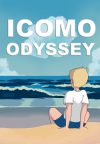
INTERLUDES are completely optional and exist purely for the readers who like a bit more nuance in their world-building. These interludes can be read in any order or skipped entirely!
They do, however, greatly enhance the story and relate to the preceding chapter.
INTERLUDE:
The archaic period
Excerpt from Dr Gabrielle Devine’s book, Our Shared Origins, published by Purkmenster University Press.
The continent that we call Icomo today was uninhabited when our ancestors first arrived there from the sea around 5,000 years ago. Early archaeological sites indicate they originally landed near present-day Niollinskport of Ii province, making it the longest continuously inhabited site in Icomo.
Within a few centuries of their arrival, they had spread out to every part of the continent, setting up temples wherever they went. They settled Co last because of the Eji Mountains which insulated that province and fortified them against invasion during the age of the warring kingdoms. By the start of the historical period when writing first appears, three distinct cultures had already sprung up. Today, we still refer to those cultures by the eponymously named provinces of the ancient period: Ii, Co, and Mo. Although their cultural differences are no longer as pronounced as before, certain tendencies remain.
The people of Ii are still regarded as being highly abstract and prone to analytical thinking. You will often find an Ii pedestrian absorbed in thought about something and unaware of their surroundings. Ancient sources tell us that every year not a small number of them were injured or killed by walking off cliffs—or in modern times, walking into traffic before roads were moved underground—because they were so distracted by some mental problem. Little has changed, but thankfully the death rate has gone down. They continue to score high on national standardized testing for math and science, and even today our inventors consistently come from Ii. In the past, they tended to be agnostic if not atheistic, so they are credited with originating ‘scientific thinking.’
To the west in Co, people live longer than anywhere else owing to their active lifestyle. Many old people still hike the Eji Mountains in shorts and t-shirts without feeling the least bit uncomfortable. They are generally hard-working and highly traditional, although prejudices of the past continue to depict them as brutish and warlike. It is true, however, that they excelled in strategizing, weapon-making, and army building. Five hundred years ago they overtook the technologically advanced Ii and the artistically flourishing Mo by sheer force, uniting the continent for the first and only time. If one looks closely, there is a strain of intellectual stoicism in Co that is not at all inferior to the complex philosophical systems of the Ii thinkers.
To the south in Mo, artists, writers, poets, and musicians have consistently risen to prominence. Although writing was invented in Ii, the people of Mo refined and elevated it, and naturally the oldest surviving piece of literature, an epic poem named The Siriad, is from Mo. Throughout its history, the Mo people have tended to be more religious, or at least more spiritual, than their contemporaries. Today, this means they are rather superstitious. They are often called ‘romantic’ by the other provinces when they want to put it nicely. What people mean by this, however, is often veiled prejudice, for the Mo also have a reputation for being lazy workers who spend more time day-dreaming than working, and devote their time to artistic pursuits or over-indulging in food, wine, and other sensuous entertainments. That being said, it is perhaps for these reasons that the arts thrive and flow passionately there, even though their spirituality has become a godless one. The people of Mo are still as vibrant and full of wonder as the frescoes of the Thioto palace complex in Vespri…
End of excerpt.


